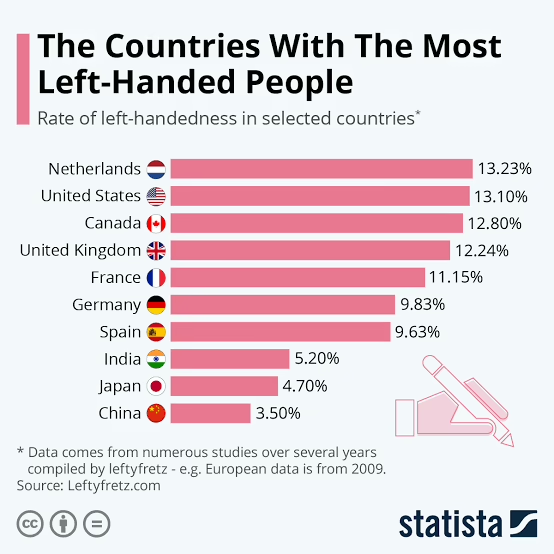Left-handedness is a unique trait found among a small percentage of the global population. Left-handed individuals naturally prefer using their left hand over their right for daily activities.
Globally, only about 10% of people are left-handed, making them relatively rare.
However, in many societies, left-handedness has often been misunderstood or frowned upon.
In some cultures, especially across the Middle East and Africa, using the left hand for certain tasks is considered inappropriate, unclean, or even disrespectful—particularly when interacting with elders.
Historically, left-handed individuals were often forced to switch to their right hand for writing and other activities, despite their natural inclination.
This social bias has contributed to the declining number of left-handed people in some parts of the world.
Despite these challenges, there are countries where left-handedness is more common and widely accepted.
Here’s a look at five countries with the highest percentages of left-handed individuals:
- Netherlands (13.2%)
The Netherlands leads the world with the highest proportion of left-handed people. Dutch society embraces individuality, and left-handed children are encouraged to develop naturally without facing discrimination. Schools and institutions support children regardless of their dominant hand. - United States (13.1%)
In the United States, left-handedness is both common and celebrated. A number of famous Americans—including athletes, entertainers, and former presidents like Barack Obama—are left-handed. The availability of left-handed tools and a culture of acceptance have helped foster a strong left-handed community. - Belgium (13.1%)
Belgium follows closely, sharing a similar percentage with the United States. Left-handedness carries no negative stigma here, and educational institutions promote an inclusive environment where children can freely use whichever hand feels most natural. - Canada (12.8%)
Canada’s open and inclusive society ensures that left-handed people face little to no discrimination. Emphasizing equality and personal freedom, Canadian schools and workplaces provide supportive environments for left-handed individuals. - United Kingdom (12.24%)
Although left-handedness was once discouraged in the UK, societal views have shifted significantly. Today, left-handed people are widely accepted. Notable British figures such as Prince William and former Prime Minister David Cameron are among the country’s prominent left-handers.










Leave a Reply